

Improving the Efficacy of Vincristine for the Treatment of Childhood Acute Lymphoblastic Leukemia in a Murine Model
Gilberto Carlos Franchi Júnior1, Anna Maria Alves de Piloto Fernandes2, Elias Paulo Tessaro3, Phellipe Honório Amaral3, Alexandre Eduardo Nowill1, Valéria Chierice2, Reza Yadollahvandmiandoab41Centro Integrado de Pesquisas Oncohematológicas na Infância (CIPOI), UNICAMP, Campinas, São Paulo, Brazil, 2ThoMSon Mass Spectrometry Laboratory, Institute of Chemistry, University of Campinas, UNICAMP, Campinas, São Paulo, Brazil, 3LABMASS – Laboratory, Campinas, São Paulo, Brazil, 4Department of Biotechnological and Applied Clinical Sciences, University of L’Aquila, L’Aquila, Italy,
Objectives: Pro-B Acute Lymphoblastic Leukemia (Pro-B ALL) is the most prevalent form of acute leukemia diagnosed in children and represents the most common malignancy of childhood. Despite the advances in the treatment of ALL, many children with ALL suffer from serious side effects of the treatment and even die due to relapse. Therefore, it is necessary to develop more effective but less toxic drugs for the treatment of ALL. Methods: In the present study we evaluated the antitumor effects of Phosphoethanolamine (Phos), alone and in com bination with the chemotherapeutic agent Vincristine (VCR) in an in vivo murine model injected with Pro-B Acute Lym phoblastic Leukemia (Pro-B ALL) and then investigate its effect on the efficacy of chemotherapeutic agent Vincristine (VCR) in combination therapy. Results: Herein, we showed that although phos is able to increase the percentage of apoptotic leukemic clones se questered by the spleen, but the ability of phos alone to reduce the percentage of leukemic clones in vivo in peripheral blood of RS4;11 engrafted mice was not observed. Phos showed a synergistic effect on VCR treatment and increased the percentage reduction of leukemic cells compared to treatment with VCR alone. Also, this combined treatment showed VCR 0.1 mg.Kg-1 is able to be as effective as VRC 0.5 mg.Kg-1 treatment in terms of percentage of leukemic cells in peripheral blood. Conclusion: Phos showed that it can improve the efficiency of VCR and thus reduce the necessary dose for antitumor effect. This suggests its use as an adjuvant agent that may reduce the toxicity associated with cancer treatment. Keywords: Acute Lymphoblastic Leukemia, Phosphoethanolamine, In Vivo, Murine Model, Vincristine
Cite This Article
Júnior G, Fernandes A, Tessaro E, Amaral P, Nowill A, Chierice V, et al. Improving the Efficacy of Vincristine for the Treatment of Childhood Acute Lymphoblastic Leukemia in a Murine Model. EJMO. 2024; 8(2): 185-193
Corresponding Author: Reza Yadollahvandmiandoab



